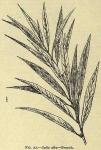 96. SALIX.—WILLOW. The bark of Sa'lix al'ba Linné, and of other species of Salix. Habitat: Europe; naturalized in North America. The best bark is that collected from the older branches, coming in thin fragments or quills, the thin brownish or yellowish periderm of which overlays a greenish parenchymatous layer. The bark from the trunk is deprived of the outer layer, pale cinnamon-brown, exfoliating; fibrous. Inodorous; taste bitter and astringent. Two varieties—white willow and purple willow, S. purpurea (see below).
96. SALIX.—WILLOW. The bark of Sa'lix al'ba Linné, and of other species of Salix. Habitat: Europe; naturalized in North America. The best bark is that collected from the older branches, coming in thin fragments or quills, the thin brownish or yellowish periderm of which overlays a greenish parenchymatous layer. The bark from the trunk is deprived of the outer layer, pale cinnamon-brown, exfoliating; fibrous. Inodorous; taste bitter and astringent. Two varieties—white willow and purple willow, S. purpurea (see below).
CONSTITUENTS.—Tannin about 12 per cent., most abundant in the white willow, and a bitter neutral principle, salicin, which is the active glucosidal constituent, occurring and coming into market in silky, shining, white needles, or grains; it exists most abundantly in the purple willow, but may be extracted from various other species and from various species of Populus, where it is combined with populin (benzoyl salicin). The degree of bitterness in the barks is probably the best criterion of the value of the several species.
96a. SALICINUM (U.S.P. IX).—It occurs in white, shining, bitter crystals, soluble in 28 parts of water and 68 parts of alcohol. Boiled with sulphuric acid it is converted into saligenin or saligenol, C7H8O2, and glucose, according to the following formula: C13H18O7+HO = (C6H4)(OH)CH2OH + C6H12O6. By oxidation with potassium bichromate and sulphuric acid, salicylic aldehyde, C6H4OH.COH, is formed, having the fragrant odor of the oil of meadowsweet (Spir'aea ulmaria) and of heliotrope. Tonic, astringent, febrifuge. Dose: 15 to 60 gr. (1 to 4 Gm.). The bark itself is rarely employed, however, salicin being used instead in doses of 10 to 30 gr. (0.6 to 2 Gm.). Ash, not more than 0.05 per cent.
Preparation of Salicin.—Obtained by adding lead subacetate to a decoction of the bark, precipitating the excess of lead with H2S. Evaporate liquid. Add, near the end of the process, sufficient quantity of animal charcoal to decolorize; filter the liquid while hot. Upon cooling, salicin will deposit in crystalline form.

